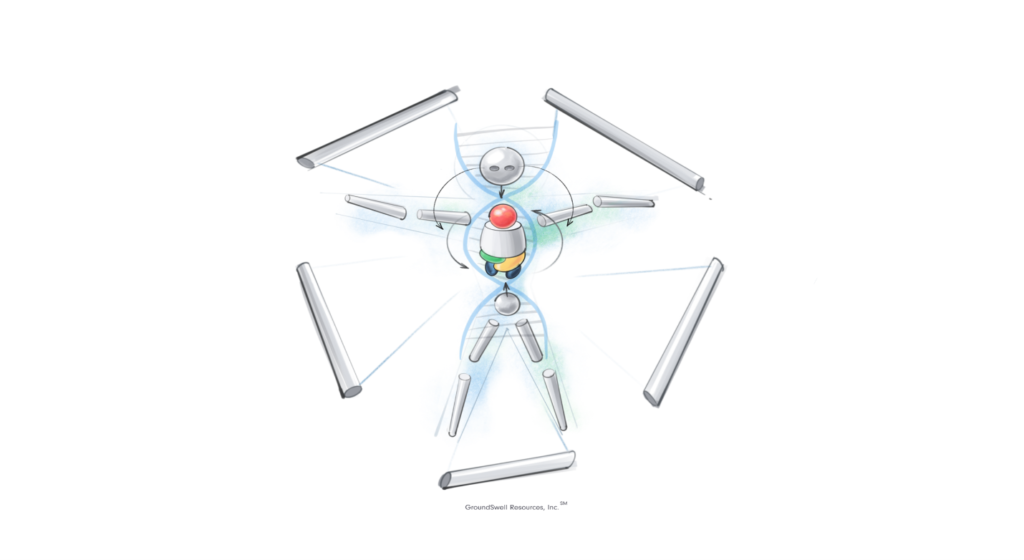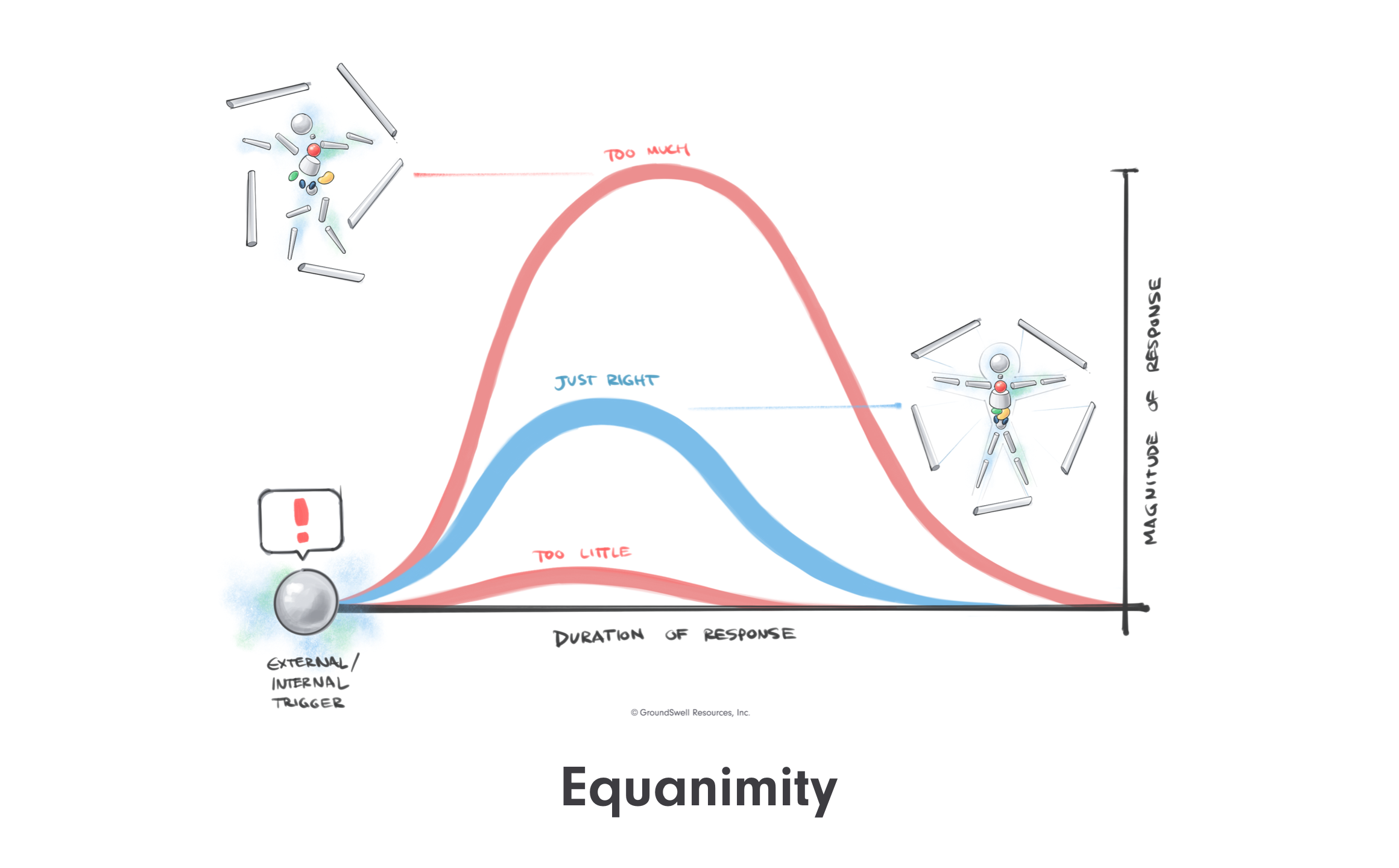We’ve seen most if not all business owners, ourselves included, struggle with the following:
- Being fully objective in their short and long-term thinking,
- Being fully present with their feelings and actions as well as the feelings and actions of others (e.g. their customers, employees, vendors, investors, etc.), and
- Simultaneously aligning and integrating what is said, felt and done with their own personal values and goals and those of their organization.
But how to solve such a dynamic issue with distinct underlying topics and fields?
We narrowed our focus to three broad categories: thinking, feeling and doing and spent nearly fifteen years researching, testing and evaluating different tools and techniques to develop a straightforward and repeatable practice that successfully addressed this multifaceted issue.
The scientific experts and practices we evaluated and integrated into solving our thinking, feeling and doing issue, both fast and slow, are detailed below.
- Thinking: Daniel Kahneman, the famous psychologist who’s studied judgement and decision making extensively and won a Nobel Prize in economics for that work, wrote the book Thinking, Fast and Slow that details two types of thinking: the fast, intuitive and emotional and the slow, deliberate and logical.
- Feeling: Daniel Goleman, the well-known psychologist who wrote Emotional Intelligence documents the significant role “low road” emotions play in our life and the associated “intelligence” that surrounds being aware of them including systems awareness, a category of systems theory, the ability to detect and map patterns and order that typically lie hidden to the casual observer in most situations.
- Doing: Thomas Myers, author of Anatomy Trains, is one of the leading experts in the world on the role of fascia in healthy and pain-free movement as well as the interrelationship of posture, alignment and movement with an individual’s thoughts and feelings. Fascia is the connective tissue under your skin that keeps your muscles, bones and organs together and connected. It also communicates through the body via compression and vibration, much like what you feel and see when you pull on a wool sweater.
- Meditation: Most meditation practices focus on monitoring and managing your thoughts through some type of repeated word or phrase, often called a mantra.
- Mindfulness: Most mindfulness practices focus on monitoring and managing your awareness and feelings.
- Martial Arts: Most martial arts practices focus on kicking and punching, but advanced forms are used for situational awareness in hand-to-hand combat; to sense your opponent’s position, line of attack and initiate your response, all without thinking. According to martial arts historians, these advanced situational practices were typically only verbally transmitted after years of practice and loyal commitment because of their inherent value. But once guns took over combat, these skills lost much of their allure. It didn’t take years of practice to accurately pull a trigger, often from far away. Today most martial arts training only focuses on the kicking and punching. The compass did the same to the Polynesian art of “wayfinding”: the ability to canoe hundreds if not thousands of miles between neighboring islands without any navigation tools.
- Interoception: We’ve also studied the little known interoception sense and various types of interoception practices and saw a connection between interoception, mindfulness, meditation and advanced martial arts and the underlying science of Thinking, Fast and Slow, Emotional Intelligence and Anatomy Trains.
We’re not renunciates or ninja warriors ready for Bruce Lee, but we’ve actively tried multiple meditation, mindfulness and advanced martial arts practices for extended periods of time, measured in years not months, and saw the benefits and limitations of each.
We spent countless hours iterating through multiple different meditation, mindfulness, advanced marital arts and interoception practices. But each practice had limitations regarding the multifaceted thinking, feeling and doing issue we were trying to solve.
Our InnerSwellSM interoception based mindfulness and meditation practice bridges, integrates and incorporates the scientific work of Daniel Kahneman (thinking), Daniel Goleman (feeling) and Thomas Meyers (doing) with the specific aspects of the meditation, mindfulness, advanced martial arts and interoception practices we evaluated and found effective solving our thinking, feeling and doing problem.
What is InnerSwellSM?
InnerSwellSM is a unique body focused emotional and mental practice that empowers the practitioner to achieve the “just right” balance between their thoughts, words, feelings and actions as well as the ability to effectively interpret and respond to the thoughts, words, feelings and actions of others.
Our practice enables pareto optimality across your thoughts, words, feelings and actions that with regular practice becomes a trait versus a state. InnerSwellSM pareto optimality implies there is no better combination of thoughts, words, feelings or actions in that moment and in the long run.

InnerSwellSM
It did take nearly fifteen years of focused research and practical trial and error. There are a lot of academic journals, ashrams and dojos out there. But we genuinely believe we’ve accomplished our objective, at least most of the time. We’re very much still human, just ask our significant others and kids.
We’ve also taught countless individuals our InnerSwellSM practice and the feedback has consistently been the same:
“InnerSwellSM takes the suck out of my day and life.”
-Warner N.
“With regular practice I can be fully present with my feelings and think clearly and not overreact.”
-Bridger C.
“I wasn’t expecting much of a change by focusing on my gut during my daily meditations, but it’s had a profound effect on how I manage my feelings.”
-Joanne L.
Think, Feel & Do with Your Gut
GroundSwell’s InnerSwellSM interoception focused practice theoretically fosters a level of conscious awareness that simultaneously interconnects the body's visceral nervous system, or the enteric brain, with the body’s facial system that creates a multi-faceted-communication system that is typically NOT fully conscious.
This unique integrated visceral focused awareness allows for traditional frontal cortex cognition (ordered, logical thinking) to be simultaneously combined with intuitive, gut thinking, feeling and action. Intuitive, emotional, low road thinking is a much faster form of "thinking" associated with the facial system with response times multiples faster than the central and peripheral nervous systems that connect with the frontal cortex. According to Thomas Myers, the fascial system “communicates around the body as mechanical vibration…traveling at the speed of sound, which is three times faster than the nervous system.” Think how fast your react when startled, otherwise known as the startle reflex. That response is not driven by thinking.
Our practice doesn’t take long to teach but typically takes time to master because most of us haven’t heard of interoception let alone practiced it. That said the underlying concepts behind InnerSwellSM are straight forward. The arrows in our InnerSwellSM image represent the movement and balancing of focus "up" from the body's visceral system to the brain/frontal cortex and then back "down" to the visceral system. That’s the gist of InnerSwellSM.
With practice, an individual can effectively learn to continue to use their frontal cortex (think, talk, write and do slowly, etc.) while simultaneously benefiting from being consciously aware of experiences that are typically considered unconscious (fast thinking, feeling and doing): the gut emotional responses in themselves and others as well as the facial expressions, tone of voice and body language in themselves and others, etc.
Our InnerSwellSM practice fosters equanimity in your thoughts, feelings and actions:

We’ve also created our Intrapersonal TensegritySM peak performance offering to supplement our InnerSwellSM practice. Your body and mind need certain baselines to perform well as a business owner like proper posture and movement, solid nutrition, general awareness of your consistent thought patterns day in and day out as well as the ability to use different types of feedback to get your body, emotions and brain into an optimized state to truly leverage the benefits of our InnerSwellSM practice.
How Do I Learn More?
In addition to our InnerSwellSM interoception training, GroundSwell’s Business Ownership PlatformSM provides the people and resources to successfully stabilize, grow, transition, or exit your business while enjoying the process.
Schedule a call now to learn more about our InnerSwellSM training.


